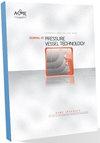磁测增压缸失效风险评估
IF 1.4
4区 工程技术
Q4 ENGINEERING, MECHANICAL
Journal of Pressure Vessel Technology-Transactions of the Asme
Pub Date : 2023-05-22
DOI:10.1115/1.4062587
引用次数: 0
摘要
压力容器和管道系统的失效风险评估是其完整性管理的重要组成部分。显然,仅使用传统程序进行风险分析存在许多缺点,这些程序本质上大多是定性的或保守的。本研究提出了一种新的极限分析方法,利用定量磁测量来确定钢容器的失效风险。首先,通过水力试验得到了受压钢瓶的物理力学性能与磁矫顽力之间的关系,发现内压增大导致磁矫顽力增大,其磁力学行为可以用线性一般表达式来描述。通过求解反问题,可以根据矫顽力测量来诊断结构向屈服区域或断裂区域的过渡,从而使我们能够在加压圆柱体失效之前进行风险评估,并通过全尺寸静水压爆试验进行验证。最后,建立了基于矫顽力测量的受压圆筒结构失效定量判别准则。本文章由计算机程序翻译,如有差异,请以英文原文为准。
Failure Risk Assessment Of Pressurized Cylinder By Magnetic Measurements
Failure risk assessment of pressure vessels and piping systems is an important part of their integrity management. Obviously, there are many shortcomings in risk analysis using only traditional procedures, which are mostly qualitative or conservative by nature. This study develops a novel limit analysis method using quantitative magnetic measurements to determine the failure risk of steel vessels. Firstly, the correlation between the physico-mechanical properties of a pressurized steel cylinder and the magnetic coercive force was obtained by hydraulic tests, it is found that increasing internal pressure leads to an increase in the coercive force, and the magnetomechanical behaviour can be described by a linear general expression. By solving the inverse problem, it is possible to diagnose the transition of the structure to the yield region or the fracture region based on the measurements of coercivity, which enables us to conduct the risk assessment prior to the failure of a pressurized cylinder, validated by a full-scale hydrostatic burst test. Finally, a quantitative criteria for identifying the structural failure of the pressurized cylinder was established based on coercivity measurements.
求助全文
通过发布文献求助,成功后即可免费获取论文全文。
去求助
来源期刊
CiteScore
2.10
自引率
10.00%
发文量
77
审稿时长
4.2 months
期刊介绍:
The Journal of Pressure Vessel Technology is the premier publication for the highest-quality research and interpretive reports on the design, analysis, materials, fabrication, construction, inspection, operation, and failure prevention of pressure vessels, piping, pipelines, power and heating boilers, heat exchangers, reaction vessels, pumps, valves, and other pressure and temperature-bearing components, as well as the nondestructive evaluation of critical components in mechanical engineering applications. Not only does the Journal cover all topics dealing with the design and analysis of pressure vessels, piping, and components, but it also contains discussions of their related codes and standards.
Applicable pressure technology areas of interest include: Dynamic and seismic analysis; Equipment qualification; Fabrication; Welding processes and integrity; Operation of vessels and piping; Fatigue and fracture prediction; Finite and boundary element methods; Fluid-structure interaction; High pressure engineering; Elevated temperature analysis and design; Inelastic analysis; Life extension; Lifeline earthquake engineering; PVP materials and their property databases; NDE; safety and reliability; Verification and qualification of software.

 求助内容:
求助内容: 应助结果提醒方式:
应助结果提醒方式:


